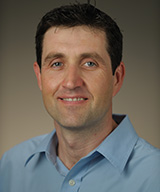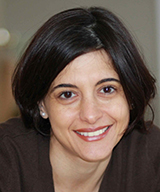Colleagues: Recently Tenured
PAUL WILLIAM DOETSCH, M.S., PH.D., NIEHS
Senior Scientist, Genome Integrity and Structural Biology Laboratory, National Institute of Environmental Health Sciences

Education: University of Maryland, College Park, Maryland (B.S. in biochemistry); Purdue University College of Pharmacy, West Lafayette, Indiana (M.S. in medicinal chemistry and pharmacognosy); Temple University School of Medicine, Philadelphia (Ph.D. in biochemistry)
Training: Research fellow, Department of Pathology, Dana-Farber Cancer Institute, Harvard Medical School (Boston)
Before coming to NIH: Professor of biochemistry, of radiation oncology, and of hematology and medical oncology at Emory University School of Medicine (Atlanta); associate director for basic research at Emory’s Winship Cancer Institute
Came to NIH: In 2017
Selected professional activities: Programmatic Panel Member (equivalent to grants council) for Department of Defense Peer-Reviewed Cancer Research Program; editorial boards of DNA Repair, Biochemistry Research International, and Nucleic Acids Research
Outside interests: Cycling (including bike trips abroad); studying military history; reading; following the University of Maryland Terrapins basketball and lacrosse teams
Research interests: More than two decades ago, my team at Emory discovered transcriptional mutagenesis (TM), which we believe may be involved in the development of cancer and other diseases. TM occurs when DNA damage in the transcribed strand of an active gene is bypassed by a RNA polymerase; the genes can miscode at the damaged site and produce mutant transcripts leading to mutant proteins that can alter cellular phenotype in the absence of DNA replication.
Also when I was at Emory, my team discovered and characterized several DNA-repair enzymes, elucidated the regulation of repair pathways, and defined relationships between DNA-damage management and genetic events that lead to basic processes important in tumor development. This information is being used for understanding cancer-cell resistance to radiation and chemotherapy as well as to develop new therapeutic strategies for cancer treatments.
At NIH, my research will continue to focus on the biochemistry, molecular biology, and genetics of DNA repair; how DNA repair is regulated; and how the transcriptional machinery interacts with DNA damage caused by environmental exposure to chemicals or radiation. We have established that TM occurs in bacterial and mammalian cells and can induced a phenotypic change. If a phenotype caused by TM results in DNA replication or cell-cycle entry, one of the resulting daughter cells may acquire a permanent DNA mutation and thus permanently establish an altered phenotype. This mechanism has been termed retromutagenesis (RM). We will be investigating how TM and RM may have a deleterious impact on human health such as contributing to the etiology of diseases and giving rise to antibiotic-resistant pathogenic bacteria.
Another area of emphasis will be to continue our studies on DNA-base-excision repair (BER). While much is known about the biochemical steps comprising BER, little is known about how the pathway is regulated or the consequences of its dysregulation. To ensure optimal protection of the genome from diverse endogenous and environment insults, the BER pathway is coordinated with other repair systems through interactions with components of other pathways. Thus, dysregulation of BER components could affect several repair pathways and contribute to human disease. The goal of our studies is to define BER-component-pathway interactions and the mechanisms and consequences of dysregulation, especially within the context of tumor development.
IAIN FRASER, PH.D., NIAID
Senior Investigator and Chief, Signaling Systems Section, Laboratory of Systems Biology, National Institute of Allergy and Infectious Diseases

Education: Heriot-Watt University, Edinburgh, Scotland (B.S. in biochemistry); Imperial College, University of London, London (Ph.D. in biochemistry)
Training: Postdoctoral fellowship at the Vollum Institute (Portland, Oregon)
Before coming to NIH: Co-director, Alliance for Cellular Signaling, Molecular Biology Laboratory, California Institute of Technology (Pasadena, California)
Came to NIH: In 2008 as an investigator in NIAID’s Program in Systems Immunology and Infectious Disease Modeling; became chief of NIAID’s Signaling Systems Unit, Laboratory of Systems Biology (LSB) in 2011
Selected professional activities: Editorial boards, Scientific Reports and Scientific Data; co-chair, NIH Systems Biology Interest Group; executive committee, NIH Oxford-Cambridge Scholars Program
Outside interests: Spending time with his wife and three children; walking and hiking; watching his kids play music and sports; playing golf
Website: https://irp.nih.gov/pi/iain-fraser
Research interests: My group’s research focuses on how inflammation and the activation of macrophages influence human disease and other pathologies. Macrophages constantly evaluate host mucosal surfaces and peripheral tissues for signs of infection or injury. The host must find a balance between tolerating beneficial microorganisms and minor nonpathological microbial organisms versus launching a robust immune response against more serious infections. Emerging evidence suggests that this decision is made by the cell based on the combinatorial signals it receives through pattern-recognition receptor (PRR) pathways that have been activated by microorganisms and endogenous stimuli.
We use high-throughput genetic screening to identify key pathway regulators, and a combination of cell biology, biochemistry, and molecular biology to characterize their function. We seek to obtain a better understanding of how PRR-signaling pathways control the macrophage inflammatory state. Ultimately, we aim to develop strategies to regulate these responses in human inflammatory diseases.
We are also developing new integrated bioinformatics approaches to data analysis that are widely applicable and freely available to the research community. We conduct comparative studies in both mouse and human systems to identify the most-important targets for potential therapeutic intervention. And, in collaboration with our LSB and NIH colleagues, we seek to link novel findings from our screens to cases of human disease. Our recent findings suggest that innate immune responses are intimately linked to the cellular metabolic state.
To extend our understanding of how macrophages integrate and respond to complex signals during encounters with pathogens, we are building models of infection based on clinically relevant bacterial species. We are studying how the combined activation of multiple pathways, including ones traditionally considered antiviral, can mount an optimal host response to clear a bacterial infection. In parallel, we are identifying mechanisms that pathogenic bacteria use to evade a host’s defense mechanisms.
What we learn will be critical to understanding how the host response is shaped and influenced by multiple microbe-derived signals, and how the response is modified by the presence of additional endogenous stimuli. Such knowledge will have important implications for understanding immunopathologic responses to infection, designing better vaccines, and determining how some pathogens evade immune responses.
CLAUDIA PALENA, PH.D., NCI-CCR
Senior Investigator, Laboratory of Tumor Immunology and Biology, Center for Cancer Research, National Cancer Institute

Education: National University of Rosario, Rosario, Argentina (B.S. in biochemistry; Ph.D. in biochemistry)
Training: Postdoctoral training in the Laboratory of Tumor Immunology and Biology, NCI-CCR
Came to NIH: In 2000 for training; in 2008 was appointed staff scientist; became tenure-track investigator in 2011
Selected professional activities: Editorial board member, Journal of Experimental and Clinical Cancer Research; editorial board member, Frontiers in Oncology (Cancer Molecular Targets and Therapeutics Section)
Outside interests: Spending time with family; listening to classical music
Website: https://irp.nih.gov/pi/claudia-palena
Research interests: The main goal of my research is to address the two central features of metastatic disease: tumor dissemination and resistance to therapy. My group is investigating how changes in the phenotype of a tumor between the epithelial and a mesenchymal-like state (a phenomenon called carcinoma mesenchymalization) could facilitate the dissemination of the tumor cells and make them resistant to anticancer therapies. My laboratory has identified the T-box transcription factor brachyury—a molecule normally expressed in the embryo but absent in normal adult tissues—as a novel tumor antigen, a driver of mesenchymalization and drug resistance in human carcinoma cells, and a target for T-cell-mediated immunotherapy. (T-box refers to a group of transcription factors involved in limb and heart development.) Our studies have shown that brachyury is overexpressed in various human carcinomas, both in the primary tumor and in metastatic sites, and that high brachyury expression in the primary tumor site is associated with poor clinical outcome. The results of these investigations led to a team science effort—including my laboratory, scientists and clinicians from the intramural and extramural scientific communities, and collaborators in the private sector—that resulted in the translation of two brachyury-based cancer vaccines from preclinical stage into phase 1 and phase 2 clinical trials in patients with advanced carcinomas and the rare tumor chordoma.
Currently, my laboratory is investigating the various signals that induce changes in tumor phenotype. We have recently demonstrated, for example, that brachyury overexpression induces the secretion of interleukin-8 (IL-8) and the expression of IL-8 receptors, and that IL-8 signaling is critical for maintaining the mesenchymal characteristics of human tumor cells. These findings may have implications for cancer therapy: A blockade of IL-8 could be a new way to target mesenchymal-like, invasive carcinoma cells.
MARK PURDUE, PH.D., NCI-DCEG
Senior Investigator, Occupational and Environmental Epidemiology Branch, Division of Cancer Epidemiology and Genetics, National Cancer Institute

Education: Queen’s University, Kingston, Ontario, Canada (B.S. in life sciences; M.S. in community health and epidemiology); University of Toronto (Ph.D. in epidemiology)
Training: Postdoctoral training at NCI-DCEG
Came to NIH: In 2004 for training; was appointed tenure-track investigator in 2009
Selected professional activities: Associate editor for Cancer Epidemiology; editorial board member for Cancer Epidemiology, Biomarkers and Prevention
Outside interests: Enjoys traveling and outdoor activities with his wife and two children
Website: https://irp.nih.gov/pi/mark-purdue
Research interests: My research centers on applying molecular and classical epidemiologic methods to studying the causes of cancer and improving the assessment of exposure to cancer-causing agents. I am particularly interested in investigating the etiology of non-Hodgkin lymphoma (NHL) and kidney cancer, and evaluating the carcinogenicity of trichloroethylene and other chlorinated solvents.
Non-Hodgkin Lymphoma: While severe immune dysregulation is an established risk factor for NHL, it is unclear whether subtle, subclinical immune-system function influences lymphomagenesis in the general population. In my research, I have found elevated circulating concentrations of the immune markers sCD23 and sCD30 to be associated with increased future NHL risk. As these have been proposed to be informative markers of B-cell activation, my findings support the hypothesis that mechanisms associated with sustained B-cell activation play a role in lymphomagenesis. I am also conducting similar research to better understand the etiology of multiple myeloma, a highly lethal B-cell malignancy.
Kidney Cancer: My leadership on genome-wide association studies (GWAS) of renal-cell carcinoma (RCC) has led to important advances in our understanding of genetic susceptibility to this malignancy. I reported the first GWAS findings for RCC, identifying variation in the EPAS1 gene as well as a nongenic region on chromosome 11q13.3 to be associated with risk. Through subsequent investigations, I identified an additional 10 genetic-susceptibility regions. These findings have provided new insight into biologic pathways affecting the development of kidney cancer. I am working to expand the size of the GWAS and am conducting investigations of gene-environment interaction with established RCC risk factors such as body-mass index, hypertension, and smoking.
Chlorinated Solvents: The industrial cleaning chemical trichloroethylene (TCE), classified by the International Agency for Research on Cancer as a kidney carcinogen, may also affect the risk for NHL. Other chlorinated solvents are also suspected to cause cancer, most notably the dry-cleaning agent tetrachloroethylene. I have been leading occupational epidemiologic studies to better understand the carcinogenicity of these chemicals. In case-control investigations using very detailed retrospective-exposure assessment methods, I found that high exposure to TCE and tetrachloroethylene is associated with increased risks of NHL and kidney cancer respectively. I am continuing to investigate the carcinogenicity of these agents within a retrospective cohort of dry-cleaning workers and in other epidemiologic studies.
WAI T. WONG, M.D., PH.D., NEI
Senior Investigator and Chief, Neuron-Glia Interactions in Retinal Disease Section, National Eye Institute

Education: Massachusetts Institute of Technology, Cambridge, Mass. (B.S. in biology; B.S.E. in chemical engineering); Washington University, St. Louis (M.D.; Ph.D. in neuroscience)
Training: Internship in surgery, transitional year program, Presbyterian Hospital (Philadelphia); residency in ophthalmology, Scheie Eye Institute, Department of Ophthalmology, University of Pennsylvania (Philadelphia); fellowship in medical retina, National Eye Institute
Came to NIH: In 2005 for training; became a staff clinician in 2007; was appointed tenure-track investigator in 2011
Selected professional activities: Principal investigator on several clinical trials in retinal diseases; editorial board of Scientific Reports
Outside interests: Playing squash and other racket sports; traveling; visiting museums
Website: https://irp.nih.gov/pi/wai-wong
Research interests: My lab is exploring the fundamental biological mechanisms that underlie retinal diseases and is translating these findings into proof-of-concept clinical studies to discover new therapies. We are trying to understand the interactions between the cellular components (neuronal and glia) of the retina. Because many retinal diseases—such as diabetic retinopathy, retinal vein occlusions, and age-related macular degeneration—involve a key inflammatory component, we have focused on how the microglial cell (the resident immune cell in the retina) interacts with other retinal cells in the healthy and diseased retina.
To examine how microglia contribute to normal neuronal function in the uninjured adult retina, we depleted microglia in a genetic model over a sustained period of time. We found no significant changes in the laminar appearance or thickness in the retina, densities of neuronal populations, or morphology of retinal neurons and macroglia. But we did find that sustained microglial depletion resulted in the progressive deterioration in the electroretinographic response, which was correlated with synaptic degeneration. Our study was the first to show that microglia are required to maintain synaptic integrity in the central nervous system and in the healthy function of the retina.
We are trying to understand how microglia undergo change in the aging retina and contribute to age-related retinal disease. In our previous work, we demonstrated that retinal microglia in mouse models undergo senescent changes in morphology, dynamic-process motility, and distribution. We discovered that aged microglia display an altered response to injury signals: They are slower to respond to acute injury but also slower to revert back to a resting state after injury resolution.
We are also studying how microglia are altered in retinal disease, how they may drive disease progression, and how they can be inhibited in preclinical experiments and in clinical trials. In earlier studies, we found that—in a mouse model for retinitis pigmentosa (RP)—microglia contributed to the overall rate of photoreceptor degeneration in RP via phagocytosis and pro-inflammatory mechanisms. We also recently discovered that tamoxifen, a drug previously associated with retinal toxicity, paradoxically conferred protection on photoreceptors via its ability to suppress microglia activation. Together these studies outline the contributions that retinal microglia can make to photoreceptor degeneration and highlight some candidate pathways and pharmacological agents that can be exploited for the therapeutic strategy of microglial modulation to ameliorate photoreceptor loss in a variety of retinal diseases.
This page was last updated on Friday, April 8, 2022
